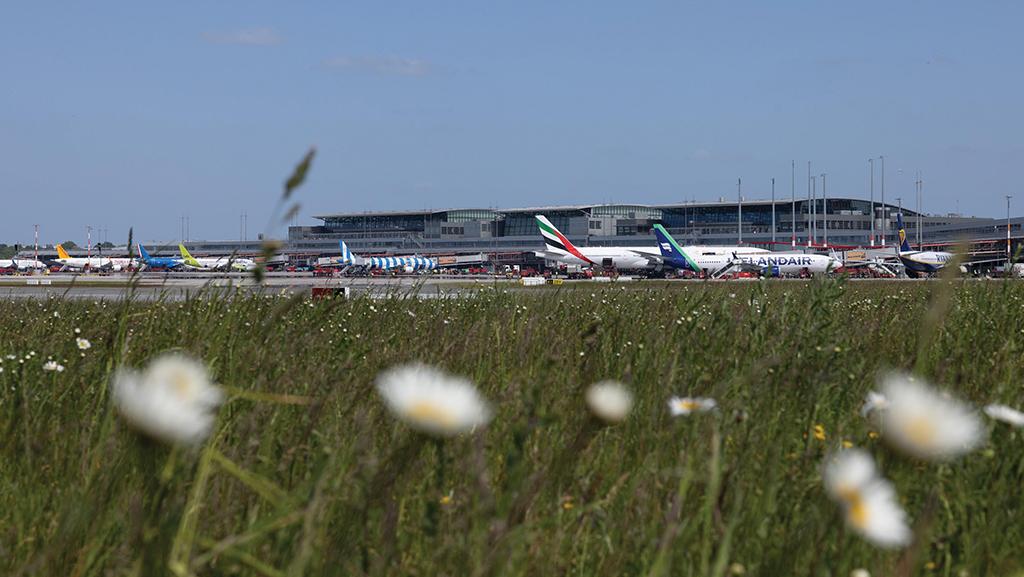
Hamburg Airport is leading a project to define requirements for a regional hydrogen flight network in the Baltic Sea Region.
Airport sustainability initiatives are an important part of the industry’s effort to achieve net-zero targets, and government funding is a vital part of the equation.
The European Union (EU) is investing in Hamburg Airport’s (HAM) initiative—the Baltic Sea Region Hydrogen Air Transport Project—to define requirements for a regional hydrogen flight network in the Baltic Sea Region. The three-year project is planned to culminate in a flight demonstration from HAM. The project has a budget of €4.8 million ($5.4 million), about 80% of which is expected to come from the EU’s interregional cooperation program (Interreg Europe). It involves 16 other partners and 24 organizations, including airport operators in Estonia, Finland, Latvia, Lithuania and Sweden. In Germany, Lubeck and Sylt Airports are involved, along with regional airline Lubeck Air and charter operator Sylt Air.
A consortium led by Glasgow Airport (GLA) that includes net-zero consulting co-developer Ikigai has obtained funding from the Scottish government to initiate a feasibility study for a hydrogen production, storage and distribution hub. The project aims to facilitate zero-emission flights at the airport and is part of the Scottish government’s £7 million ($8.7 million) Hydrogen Innovation Scheme, dedicated to advancing renewable hydrogen technologies.
Teesside International Airport (MME) in northeast England will become home to a new permanent hydrogen refueling station as part of a wider £8 million ($10.1 million) UK government investment. The airport previously played host to a temporary refueling station and secured low-emission, hydrogen-fueled vehicles as part of a regional trial in 2021. Hydrogen infrastructure specialist Element 2, which established the previous temporary station, will set up another temporary refueling station in 2024 and then a new permanent station in late 2024 to early 2025.
In the US, as part of the government’s Airport Improvement Program (AIP), FAA announced in July that it has invested nearly $92 million in 21 airports for solar panels, electric buses, charging stations and electrification studies. The AIP provides more than $1.18 billion annually in entitlement and discretionary grant funds for more than 3,300 eligible US airports. Almost $47 million of the total will go to key sustainability projects, including energy-saving solar power equipment and infrastructure to Indianapolis International Airport, Indiana ($22.58 million); Phoenix Sky Harbor International Airport, Arizona ($20 million); El Paso International Airport, Texas ($3 million); Southeast Iowa Regional Airport in Burlington, Iowa ($600,000); La Porte Municipal Airport in Indiana ($333,450); and Centerville Municipal Airport, Iowa ($150,000) and Decorah Municipal Airport, Iowa ($150,000).
An additional $44.5 million was awarded by FAA to 13 airports to plan for and purchase electric vehicles and electric transportation infrastructure.
In Canada, a hydrogen fueling station will be built at Toronto Pearson International Airport (YYZ) for cars and trucks serving the airport. The station will mark the first public refueling site for vehicles with hydrogen fuel cells in the province of Ontario and only the sixth overall in Canada. The YYZ fueling station will be financed via a C$1 million ($750,000) investment from the Canadian government.
Airport Investments
Amsterdam Airport Schiphol (AMS) has invested in a variety of energy-saving initiatives, such as LED lighting, energy-efficient equipment, and a cogeneration plant. In addition, Royal Schiphol Group plans to collaborate with network operator Liander to create a new high-voltage substation to provide Schiphol with more capacity on the grid. The new high-voltage substation, to be built in 2027, will supply power to the terminal and offices, among other locations. Schiphol’s ambition is for all its own buildings at the airport to be off the gas grid by 2030.
Sakowin, a French startup company participating in Paris airport operator Groupe ADP’s H2 Hub Airport project, has made progress toward producing hydrogen from methane. The concept is targeting green generation of hydrogen, with solid carbon as a byproduct.
Air New Zealand is inviting airports to apply to participate in its plan to operate commercial demonstration flights with electric or other alternative-propulsion aircraft beginning in 2026. The carrier aims to select two New Zealand airports that will be at either end of the route used in the program. Air New Zealand has issued a call for expressions of interest from airports, and the successful applicants will be named in the second quarter of 2024.
Airline SAF Initiatives
Airlines are ramping up SAF production with partnerships and investments.
Lufthansa Group signed an agreement with hydrocarbons supplier HCS Group for SAF produced within Germany. Situated near the airline’s Frankfurt hub, the manufacturing site operated by HCS Group’s Haltermann Carless brand in Speyer, Germany, will produce SAF from waste biomass generated by the agriculture and forestry sector from early 2026.
International Airlines Group (IAG) made a “significant” but undisclosed investment in Nova Pangea Technologies, which plans to build a plant in the UK to convert agricultural waste and wood residues into bioethanol for processing into SAF. The investment will support construction of the NovaOne waste-to-fuel plant in Teesside in northeast England. It is planned to be operational by 2025.
The Australian government launched a A$30 million ($20 million) initiative to support development of a domestic SAF production industry. The initiative follows the June establishment of the government’s Jet Zero Council to identify opportunities to decarbonize the sector.
Air China completed the country’s first uptake of SAF in a commercial flight on July 14 when an Airbus A350-900, flying from Hangzhou Xiaoshan International Airport to Beijing, took in fuel with a 10% SAF blend from local supplier Sinopec.
Virgin Atlantic and Rolls-Royce completed a SAF blend ground test on the Trent 1000 engine. The test marks a key milestone in the project, which plans to see the world’s first 100% SAF flight travel across the Atlantic from London Heathrow to New York JFK with a Boeing 787, set to take off Nov. 28.





